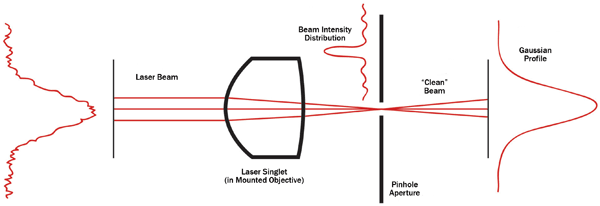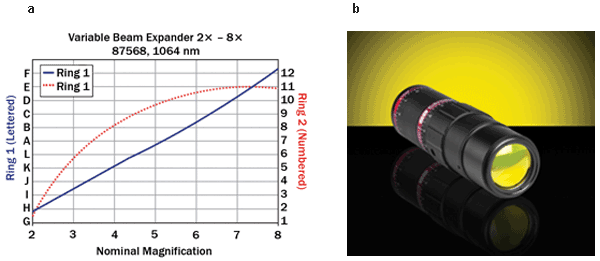Ra’ef, Mikhail, Edmund Optics
The first feature article in this series (“Selecting Industrial Laser Optics,” January 2014, pp. 11-13) discussed a variety of extracavity optical laser components and their importance to laser operation and laser beam delivery. This article will focus on using beam expanders to manipulate the cross-sectional area of a laser beam or beam size.
"Focused as a laser beam" – what does that really mean? Whenever that statement is used, it’s related to the unique properties of a laser’s directionality and collimation, not focusability. Understanding your application is vital when selecting optical components because, in most cases, the optical component can influence the performance of the entire system. For example, in cases where high laser-damage thresholds are required, sacrifices must often be made in optical or spectral performance to meet cost requirements.
Extracavity laser optics can be separated into two main categories: beam manipulation and beam delivery. Typically, both are required in an industrial laser application. In most cases, the beam emitted by the laser does not have the size, shape and intensity profile desired for the beam delivery system or for induced distortion by the beam delivery system. Beam manipulation is often required to adjust or correct the laser beam attributes for the desired application.
Beam expanders are the most appropriate way to configure the laser beam size for an application. With different configurations available, it is important to choose the right beam-expander design for the application.
What is a beam expander?
In their simplest forms, beam expanders are inverted telescopes comprising a short-effective-focal-length (EFL) lens followed by a long-EFL lens, and the magnification is the ratio of the long focal length to the short focal length.
Lenses are made with either one or both surfaces curved; depending on the application, you can select which surface is curved, its curvature profile and whether it has a positive or negative focal length (Figure 1).

Figure 1. (a) A converging or positive lens; (b) a diverging or negative lens. Photo courtesy of Edmund Optics.
A collimator consists of a light source, a pinhole simulating a point source and a positive lens. If the pinhole is located at the focus point of the lens, the light collected by the lens will be collimated. Generally, the smaller the pinhole, the better the light collimation from the lens.1
Using the principles of collimation and focusing, a simple beam expander can be configured as illustrated in Figure 2. The lenses are separated by the sum of their focal lengths, where the beam magnification is the ratio of the longer focal length to the shorter focal length, as described by Equation 1.

Expanding the laser beam is important if the divergence needs to be reduced. Since beam divergence is inversely proportional to the magnification of the optical system, a larger beam produces less divergence relative to a smaller beam. This is extremely useful in applications where a laser beam needs to be projected to a large distance, as in ranging and communications, conserving the energy density at a larger area. The divergence decreases by the same factor of magnification. Selecting the appropriate optics for the laser system will allow for not only reduction in divergence, but also diffraction-limited focusing to increase the energy density by more than 10,000 times. Finally, when working with high-energy laser beams, beam expansion allows less incident energy per unit area, therefore protecting expensive optics and photonics in the optical system.
For example, if a laser with a beam diameter of 0.96 mm and angular divergence of 1.15 mrad were pointed at the moon – 384,400 km from Earth (average) – the spot size incident on the moon would be 442 km wide. However, if the beam size were to increase 100× to 9.6 cm, the spot size at the moon would be 4.42 km, a factor of 100 smaller than without a beam expander. Additionally, the power density, using a 1000-W laser, would increase from 0.0065 W/km2 to 72 W/km2, respectively, an increase of four orders of magnitude.
Different configurations
There are two main configurations for beam expanders: Keplerian and Galilean. For the sake of simplicity, the configurations will feature two-element designs. The Keplerian is possibly the more familiar, easier design that features two positive lenses, where the overall system length is the sum of the focal lengths. The Galilean design, which is more popular, utilizes a negative lens as the short-EFL lens and a positive lens as the long-EFL lens (Figure 2).

Figure 2. (a) Keplerian beam expander; (b) Galilean beam expander. Photo courtesy of Edmund Optics.
The advantage of the Keplerian beam expander is its simple design, but the intermediate focus plane makes it nonideal for high-power laser applications. For many lasers, the energy density at the focused spot could increase 10,000 times, making it so intense that the air would be ionized. Unfortunately, when the air is ionized, most of the laser’s energy is absorbed, creating a spark and an audible sound. Loss of energy is not the only drawback, either, as the spatial and temporal pulse shape will become distorted. To combat this problem, a vacuum can be created in between the lenses, but this is not practical in most situations.
The Galilean design doesn’t have an intermediate focus plane, making it ideal for high-power lasers. Galilean beam expanders are generally shorter than Keplerian ones with a similar magnification. Beam expanders can be used in reverse as a beam minimizer, decreasing the overall beam diameter; however, beam divergence also increases by the same factor of magnification. Generally, most designs are optimized to be used as beam expanders and not minimizers. In applications that do not require high-power lasers, Keplerian beam expanders are advantageous, because they allow the use of a spatial filter.
A spatial filter removes the high-frequency spatial intensity fluctuations that most laser beams exhibit, even when the laser is operating in the fundamental mode (TEM00). The noise can be attributed to many variables, including inhomogeneity in the glasses used in the optics, dust and alien objects on the optical surfaces, and so on. A spatial filter is nothing more than focusing the laser beam into a pinhole to remove the high spatial intensity fluctuations from the Fourier plane of the object, as illustrated in Figure 3.2

Figure 3. A spatial filter configuration removes the intensity fluctuations in a TEM00 laser beam. Photo courtesy of Edmund Optics.
Keplerian and Galilean designs can be configured into fixed-magnification or variable-magnification beam expanders.
Variable beam expanders
Variable beam expanders are extremely advantageous in many applications where the magnification needs to be finely tuned and a plug-and-play magnification is not suitable. These expanders use internal translation and focusing mechanisms to continuously adjust magnification and laser divergence to optimize system performance. Generally, they are complex, multi-element Galilean designs that allow for adjustment over a continuous magnification range (Figure 4) and are commonly preferred for use with high-power lasers.
Selecting a variable beam expander
A few key specifications must be considered when selecting a variable beam expander, including optical and spectral performance, durability and built-in design considerations.

Figure 4. Multi-element Galilean-designed variable beam expander. Photo courtesy of Edmund Optics.
First and foremost, in most laser systems, it is crucial to maintain the wavefront. When selecting a variable beam expander, choose one with a low transmitted wavefront distortion; for most applications, anything quarter-wave or better is good enough. When optical manufacturers are designing variable beam expanders, they can optimize the performance for one of two things: wavefront distortion or magnification error. Because it’s a variable beam expander, it’s trivial to optimize the design for magnification error, as the correct magnification can always be finely tuned using the adjustments. However, the wavefront distortion cannot be adjusted. If you are designing a variable beam expander, ensure that the spherical aberration is minimized for the optical elements. Figure 5 (a) illustrates the movement chart used to select or dial in the nominal magnification for Edmund Optics’ 1064-nm 2×–8× variable beam expander with the alpha and numeric rings on (b).

Figure 5. (a) A 1064-nm variable beam expander movement chart for selecting a continuous range of magnifications; (b) alpha and numeric rings. Photo courtesy of Edmund Optics.
Second, using a high-energy laser requires a few key considerations. A Galilean design is important; using a Keplerian design can be devastating to the variable beam expander as well as to the application. Also, the optics must be coated with a high-laser-damage-threshold dielectric antireflection thin film to ensure maximum transmittance through the variable beam expander without destroying the optics. However, maximum transmittance isn’t the only advantage of a good antireflection coating; reflections can have destroying effects. A good design would have minimal ghost reflections that focus internally or externally to the variable beam expander. For example, a 1-kW laser incident on a coating with a 0.1 percent reflection will reflect 1 W. If a focusing ghost reflection is present, the 1-W reflected power can increase up to 10,000 W per unit area, which can be devastating to optics or even become a safety hazard.
It’s always good practice to incorporate a very large convex radius of curvature on the input surface of the variable beam expander. This allows the backreflection to slowly diverge, minimizing it into the laser system and mitigating possible damage. Finally, a good design should incorporate nonrotational travel as the magnification is adjusted.
In addition to beam expanders, there are many optics to consider when building a laser system. To learn more, see “Selecting Industrial Laser Optics,” which appeared in the January 2014 issue.
Meet the author
Ra’ef Mikhail is an optical engineer and the laser-optics product line engineer at Edmund Optics in Barrington, N.J.; email: [email protected].
References
1. Collimators and Autocollimators. Laser/electro-optic Devices: Course 7. Comp. Cord Communications. Waco, Texas: Center for Occupational Research and Development, 1986. pp. 167-180.
2. E. Hecht (2002). Optics. 4th Ed. Pearson Education.